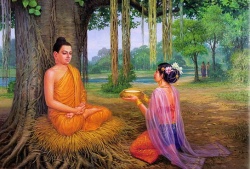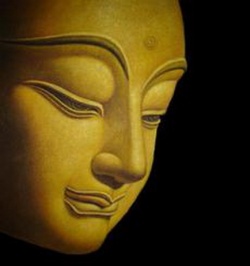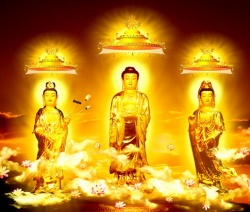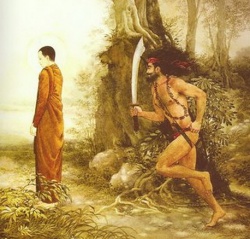Desire: The cause of all suffering
With so much suffering in the world today – on an individual level as well as nationally and globally – wouldn’t it be wonderful if someone could discover and point out to us the actual CAUSE of all suffering so that we could eliminate the cause and thus perhaps eliminate suffering itself, making the world a much happier and more peaceful place in the process?
2,600 years ago in India, someone did discover and point out – clearly and repeatedly – the actual cause of all suffering and the way to freedom from suffering. His name was Siddhartha Gautama and he is better known to us today as Buddha (meaning “The Enlightened One”), the founder of the spiritual philosophy known as Buddhism.
The main essence of his teachings, and the very foundation of Buddhism, is encapsulated within what he called the Four Noble Truths. Madame Blavatsky wrote that if humanity at large would ever accept the Four Noble Truths and live their lives accordingly, then “indeed an era of bliss and peace would dawn on Humanity.”
These are the Four Noble Truths that Buddha presented:
- 1. Suffering is the unavoidable accompaniment of physical existence.
- 2. All suffering is caused by desire.
- 3. All personal desire and ambition must be extinguished by the person who wishes freedom from suffering and it can be extinguished by walking the Path.
- 4. The Path which leads to freedom from suffering is a narrow path.
A clear illustration of how Buddhism is misrepresented and misunderstood in the West today is the fact that many Western Buddhists have never even heard of the Four Noble Truths and are not at all aware of Buddha having been so anti-desire. There are many in the West today who, either through ignorance or ulterior motives, present Buddhism as being a sort of “anything goes” path and even try to claim that Buddha’s teachings are aligned with the so-called “Law of Attraction” teachings of today, which purport that desire is divine and that we can and should manifest our personal desires through positive thinking and visualisation, etc. Still others, under the guise of Buddhism, encourage their followers to chant certain mantras in order to become rich and successful.
These things are of course the very antithesis of Buddhism and the teachings of its Founder and no-one who has read Buddha’s teachings for themselves (or who know anything of his life story) could fall prey to such delusional and even dangerous notions. I call them “dangerous” because, according to Buddha himself, the continuation and intensification of desire brings about the continuation and intensification of suffering.
It is becoming increasingly popular for people to call themselves Buddhists and usually without any knowledge at all of Buddha’s teachings. This is a great shame because it causes Buddhism to be misrepresented and it is in Buddhism that the cause and cure of suffering are most clearly and perfectly delineated.
- “Desires are never satisfied, not even by a shower of gold. He who knows that the enjoyment of passion is short-lived and that it is also the womb of pain is a wise man.”
- “The disciple of the Supremely Enlightened takes delight in the destruction of desire.”
- “The man who has killed all desires…he indeed is exalted among men.”
- “It is not good conduct that puts you on the path to liberation, nor will ritual do it, nor book learning, nor seclusion and solitude, nor meditation. None of these alone can bring mastery or joy. It is desirelessness that does it.”
- “Those who seek perfection must keep watch by day and night until all desires vanish.”
- “From passion and desire, sensuousness and lust, arise grief and fear. Free yourself from attachment.”
- “The master…cuts all ties. He gives up all his desires. He resists all temptations. And he rises. And wherever he lives, in the city or the country, in the valley or in the hills, there is great joy. Even in the empty forest he finds joy, because he desires nothing.”
- “Desire never crosses the path of virtuous wakeful men. Their brightness sets them free.”
- “Let us, then, free from the disease of desire, live happily amongst those who suffer that disease; among men with disease of desire let us dwell free from that disease.”
The above are just ten of many such statements found in the Dhammapada, which is the basic and foundational scripture of Buddhism, being a collection in just over 420 verses of Gautama Buddha’s sayings. It is clear there and elsewhere that he did indeed mean what he said in the Four Noble Truths…that “desire is the cause of all suffering” and that the extinguishing of desire will equate to the extinguishing of suffering.
In fact, to quote again from the Dhammapada, “The end of desire is the end of suffering” and “When desire leaves you, never to return, suffering has left you, never to return.”
If we think about it, we can easily see that the statement “All suffering is caused by desire,” is perfectly true. The woman who is suffering emotionally because her romantic relationship came to an end…her suffering is ultimately the result of the desires she had for love. The man who is suffering financially because of the failure of his big business…his suffering is ultimately the result of the desires he had for wealth and material success. Some suffering, particularly physical suffering, seemingly cannot be traced to the root cause of desire in this particular lifetime but were we able to go back far enough we would surely find the “disease of desire” (as Buddha called it) that created that suffering, for every negative effect is the karmic product of a negative cause and every negative cause was born out of desire, greed, ambition, lust, and selfishness, which are all slightly different forms of one and the same thing.
SELFISHNESS is the great curse of the human race.
The person who desires nothing suffers nothing. Think about it even for 10 seconds and you will see the great and powerful truth of this teaching. Selflessness, rather than selfishness, was one of the main things Buddha was trying to put across in his teachings. I personally am more drawn to Hinduism than to Buddhism as a whole but I readily admit that there is one important area in which Buddhism triumphs over Hinduism and that is in its constant emphasis on selflessness and the destruction of every last trace of selfishness. Both religions present liberation from the cycle of death and rebirth as being the great goal and both religions state that this cannot be achieved without reaching a state of complete and utter desirelessness…but Hinduism often tends to present all this as just being a way to escape from this earth, disappear forever, merge completely into Brahman, and never have to be bothered about earthly things again.
But the person who pursues and achieves “moksha” (liberation) just so he can be reabsorbed into the Absolute and never have to spare another thought for life on earth, is surely the most selfish type of person there is!
As is said in “The Voice of The Silence,” translated by Madame Blavatsky from the Book of The Golden Precepts – “Shalt thou be saved and enter into Nirvana while the whole world cries with pain?” The highest goal presented in Mahayana Buddhism is to become a Bodhisattva; one who pursues the path of spiritual development and advancement solely for the sake of being of the utmost help and service to humanity and who, upon eventually reaching to the very threshold of Nirvana, renounces its eternal bliss in order to keep consciously reincarnating on earth so as to help and serve others and to help guide them along the way too.
A Tibetan Buddhist would say that anything other than this is selfishness. And, really, who could disagree? Look at these profound and inspiring verses from the Bodhicharyavatara (better known as “The Way of the Bodhisattva”) written about 1,300 years ago by the Indian Buddhist Shantideva. This is one of the most revered and important texts of Mahayana Buddhism and the present Dalai Lama has said, “If I have any understanding of compassion and practice of the bodhisattva path, it is entirely on the basis of this text that I possess it.”
- “Directly, then, or indirectly, do nothing that is not for others’ sake. And solely for their welfare dedicate your every action to the gaining of enlightenment.”
- “The pain of gaining, keeping, and of losing all! See the endless hardships brought on us by property! For those distracted by their love of wealth [or “comfort” or “luxury”] there is no chance for freedom from the sorrows of existence.”
- “They indeed, possessed of many wants, will suffer many troubles, all for very little.”
- “Indeed, O foolish and afflicted mind, you want and crave for all and everything. All this together will rise up as pain itself, increased a thousandfold. Since this is so, the wise have no attachments; from such cravings fear and anguish come. And fix this firmly in your understanding: all that may be wished for will by nature fade to nothing.”
- “All the joy the world contains has come through wishing happiness for others. All the misery the world contains has come through wanting pleasure for oneself.”
And in the true spirit of a Bodhisattva, Shantideva continues…
Perceiving now the faults possessed by “I,”
The ocean of good qualities that are in “other,”
I shall lay aside all love of self
And gain the habit of adopting other beings.
~ ~ ~
For all those ailing in the world,
Until their every sickness has been healed,
May I myself become for them
The doctor, nurse, the medicine itself.
~ ~ ~
And now as long as space endures,
As long as there are beings to be found,
May I continue likewise to remain
To drive away the sorrows of the world.
“Ambition taints the soul,” says the Master Morya in one of the Mahatma Letters. It is undeniable that as long as a person still has one lingering shred of personal desire or ambition, they are limited in the help and service they can give to humanity. Personal desires, dreams, goals, ambitions – all these things that the world presents as being vitally important and essential to the happiness of a human being – are really nothing other than selfishness and, as said, it is SELFISHNESS that is the great curse of humanity.
The only aim and ambition that is really worth having in life is to help and to serve humanity. Unfortunately, in a world that is becoming more and more selfish by the day, this type of statement and spiritual teaching is becoming more and more unpopular by the day. The idea of anyone actually being able to be free from all personal desire sadly seems impossible and extreme to many spiritual people today, whereas even more extreme and impossible sounding teachings such as manifesting a gigantic mansion for oneself through the power of the mind are often readily and unquestioningly accepted as being plausible and worthy of attention. Such is the age we live in!
But just knowing that desire is the cause of suffering doesn’t completely solve the problem. If all suffering is caused by desire, then what is the cause of desire itself and how can we free ourselves from it?
The religion of Hinduism, to which the Lord Gautama belonged, talks about the “three knots of the heart,” being Avidya – Kama – Karma. This means Ignorance – Desire – Karma (Action and Reaction). All suffering is born of desire and all desire is born of ignorance. So say the spiritual teachings of the East. It is ignorance, lack of knowledge, of our own real nature, of the real nature of things, and of the real nature of existence itself, that causes us to desire things. If a person truly knows Who and What he really is, he will desire nothing.
Knowing that you are not the body and that this physical body is nothing more than our outer shell…knowing that you are not the emotions…knowing that you are not even the mind…knowing that you are pure eternal Spirit, completely and literally ONE in essence and identity with the Absolute and that all else is no better than illusion because it is impermanent, temporary, finite, and subject to change…how can you desire anything in this material manifested world?
“Illusion” has become a popular buzzword today in many spiritual circles but it seems that many of those who go around saying that everything is illusion are still buying into the illusion themselves, as evidenced by the continuation of their personal desires and ambitions. If you REALLY know and believe that everything material and objective is illusion and impermanent, then you will desire nothing. Your only wish will be to help and to serve others. This is the only true and unending source of joy and this is the way to freedom from suffering.
The desireless person is not a joyless person. In fact, he has more joy than anyone else because he is attached and attracted to nothing, knowing that all things are passing, fleeting, and temporary, in the world of the senses. Because he has no personal desire, no personal aims and ambitions, no personal goals and self-centred intentions, he can enjoy all things that come his way while they last, knowing that nothing lasts forever. In the words of the Isha Upanishad, “you should enjoy all things, after giving up the desire for them.”
If good things come your way, you are joyful. If nothing good comes your way, you are joyful. If good things come your way and then depart, you are joyful. As Buddha said…
“When you desire nothing from this world and nothing from the next, you are free.”
By MW, October 2012
NOTE: It is important to remember that there are two main forms of Buddhism, the Mahayana and the Theravada. The basic fundamental teachings of both are the same but they differ greatly from one another in quite a number of other aspects. Mahayana Buddhism is also known as Northern Buddhism and, in various forms and expressions, is the Buddhism of such countries as Tibet, Nepal, Bhutan, Mongolia, China, etc. This is the more metaphysical, transcendental, complex type of Buddhism.
Theravada Buddhism is also known as Southern Buddhism and is the Buddhism of countries such as Thailand, Cambodia, Myanmar, Sri Lanka, Malaysia, and Singapore. This is the more “stern, cold, blank” form of Buddhism and has no esoteric side to it but it is often said to have preserved more faithfully the original public teachings of the Lord Buddha. Vietnamese Buddhism shows both a strong Mahayana and Theravada influence and cannot really be definitely categorised as either. Zen, which originated in China but blossomed in Japan, is an offshoot of Mahayana but is said by some to have more in common with Theravada.
In actuality, Theravada Buddhism is the outcome of the Buddha’s public and exoteric teachings while Mahayana Buddhism is the outcome of his esoteric teachings which he confined to his closest inner circle and Arhats. Madame Blavatsky, who was recently said by a modern expert on Buddhism to have known and understood its “content and philosophical import better than any Western contemporary,” wrote in The Key to Theosophy that “REAL Buddhism can be appreciated only by blending the philosophy of the Southern Church and the metaphysics of the Northern Schools.”






